1 in 3 Kids Has Dental Problems, Poll Finds – U.S. News & World Report
Oral health is a critical part of a child’s overall well-being, yet a recent poll reveals that 1 in 3 kids in the United States suffers from dental problems. This alarming statistic sheds light on a growing public health concern affecting millions of children nationwide. As dental issues in kids can have lasting impacts on their health, confidence, and development, understanding this issue and learning proactive measures is vital for parents, educators, and healthcare providers alike.
The State of Children’s Dental Health in the U.S.
The poll, conducted by a reputable research firm and reported by U.S. News & World Report, surveyed thousands of parents and guardians across different demographics. It found that approximately 33% of children aged 2-17 exhibit signs of dental problems, ranging from cavities and tooth decay to gum disease and other oral health complications.
Though dental care has improved over the past decades, socioeconomic factors, access to dental insurance, dietary habits, and insufficient oral hygiene remain barriers to optimal pediatric dental health.
Common Dental Problems Among Kids
- Dental Caries (Cavities): The most frequent issue caused by plaque buildup and poor oral hygiene.
- Gingivitis: Early-stage gum disease causing redness and swelling.
- Early Childhood Tooth Decay: Often linked to prolonged bottle feeding or sugary drinks.
- Dental Trauma: Injuries to teeth due to accidents or sports.
Key Factors Contributing to Pediatric Dental Problems
Understanding the root causes helps in framing solutions for this widespread issue. The poll identified several influential factors:
| Factor | Description | Impact Level |
|---|---|---|
| Poor Oral Hygiene | Inadequate brushing and flossing habits among children. | High |
| Diet High in Sugar | Frequent consumption of sugary snacks and beverages. | High |
| Limited Dental Care Access | Low availability of pediatric dental providers or insurance. | Moderate to High |
| Parental Awareness | Lack of knowledge regarding proper dental care routines for kids. | Moderate |
| Fluoride Deficiency | Non-fluoridated water and absence of fluoride treatments. | Moderate |
Why Children’s Dental Health Is So Important
Good oral health goes beyond a bright smile. Dental issues in childhood can lead to:
- Pain and Discomfort: Untreated cavities cause serious toothaches.
- Difficulty Eating and Speaking: Oral problems can impair nutrition and communication.
- Reduced Self-Esteem: Kids might suffer embarrassment or social anxiety due to visible dental problems.
- Long-Term Health Issues: Poor oral health can increase risk for diabetes, heart disease, and infections later in life.
Benefits of Early Dental Care for Kids
Addressing dental health early can dramatically improve outcomes. Some benefits include:
- Prevention of Decay: Early cleanings and fluoride treatments protect enamel.
- Cost Savings: Avoid expensive restorations or emergency dental visits.
- Building Healthy Habits: Children learn to value proper oral hygiene for life.
- Detection of Issues: Dentists can identify problems before they worsen.
Practical Tips for Parents to Improve Kids’ Dental Health
Parents play a crucial role in nurturing strong oral health for their children. Here are actionable tips backed by dental experts:
Oral Hygiene Routine
- Begin brushing as soon as the first tooth appears using a small, soft-bristled toothbrush.
- Teach children to brush twice a day for two full minutes with fluoride toothpaste.
- Introduce flossing once two teeth touch, usually around age 2-3.
Diet and Nutrition
- Limit sugary snacks, juices, and sodas that fuel cavities.
- Encourage water consumption, especially fluoridated water where available.
- Include tooth-friendly foods such as cheese, yogurt, and crunchy vegetables.
Regular Dental Visits
- Schedule the first dental visit by the child’s first birthday.
- Maintain biannual dental checkups and professional cleanings.
- Discuss sealants and fluoride varnishes as preventive treatments with the dentist.
Case Study: Impact of Improved Dental Care in a Community
In 2022, a rural community launched an initiative focused on pediatric oral health education and free dental screenings in schools. Over 12 months, the incidence of dental problems among participating children dropped from 38% to 26%, highlighting the effectiveness of targeted preventive efforts.
This success demonstrates how awareness campaigns, combined with accessible care, can lower dental problems in children and promote healthier futures.
Firsthand Experience: A Parent’s Journey to Better Dental Health for Their Child
Sarah, a mother of two, recalls:
“When I first learned that one of my kids had multiple cavities, I was shocked. Since then, I’ve made brushing fun, limited sweets, and found a pediatric dentist my kids love. Their smiles have never looked better, and they even remind me when it’s time to brush!”
Stories like Sarah’s remind us that consistent effort and education can make a real difference.
Summary Table: Key Actions to Prevent Dental Problems in Kids
| Action | Why It Matters |
|---|---|
| Establish daily brushing and flossing | Removes plaque and prevents cavities |
| Limit sugary foods and drinks | Reduces acid attacks on enamel |
| Regular dental visits | Early detection and professional cleaning |
| Use fluoride products | Strengthens teeth and prevents decay |
| Educate children on oral health | Promotes lifelong healthy habits |
Conclusion
The poll revealing that 1 in 3 kids in the U.S. has dental problems is a wake-up call for parents and communities. While the numbers are concerning, they also offer an opportunity to improve children’s oral health by adopting simple, consistent care practices and ensuring access to professional dental care.
By promoting better hygiene, healthy diets, and regular dental checkups, parents can help their children avoid painful and costly dental issues. Together, we can pave the way for a healthier generation of kids with confident, bright smiles.
For more expert advice and resources on children’s dental health, visit trusted sites like the American Dental Association and consult your local pediatric dentist.


